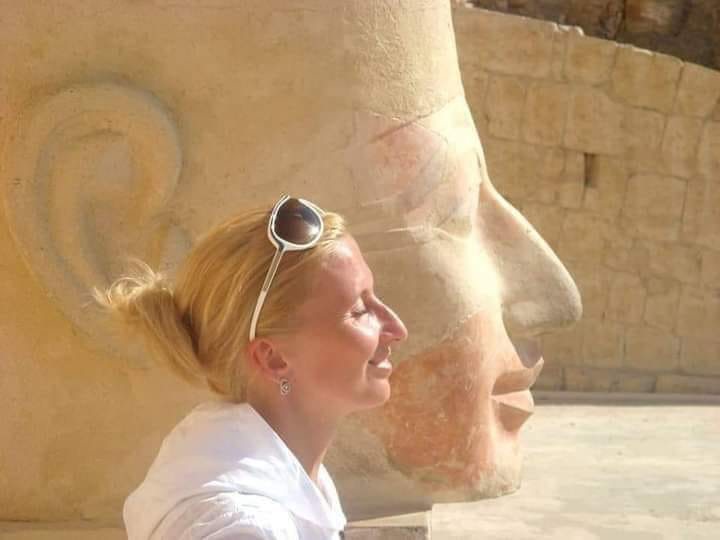There are moments in travel when the modern world collides with the ancient, offering an unforgettable connection to the past. This image of a foreign tourist, smiling in peaceful harmony next to the statue of Queen Hatshepsut, captures one such moment, a serene reflection of history and human continuity.
The Majesty of Queen Hatshepsut
Queen Hatshepsut, one of the most extraordinary rulers in ancient Egypt, reigned during the 18th Dynasty, around 1479–1458 BCE. As Egypt’s longest-reigning female pharaoh, she ruled not as a queen consort or regent, but as a full-fledged monarch. In an unprecedented move for a woman of her time, she depicted herself as a male ruler in statues and reliefs, complete with the traditional pharaonic beard and attire. Her reign was marked by peace, prosperity, and monumental building projects that have left a lasting legacy in the sands of Egypt.
Her most famous architectural achievement is the mortuary temple at Deir el-Bahari, located on the west bank of the Nile, near the Valley of the Kings. The grand temple is carved into the cliffs, with terraces and colonnades that rise majestically from the desert floor. It stands as a testament to her vision and ambition, forever enshrined in Egyptian history.
A Traveler’s Timeless Connection
The photograph of the tourist standing next to the colossal statue of Queen Hatshepsut at Deir el-Bahari brings forth an intriguing juxtaposition of ancient and modern. The tourist, with her sunglasses resting on her head and a calm, thoughtful smile, reflects a deep connection with history, as if contemplating the weight of time itself. The statue, weathered by thousands of years, gazes into eternity, unmoved by the passage of centuries.
This image is more than just a fun travel snapshot; it symbolizes the human desire to reach across time, to connect with those who lived long before us. For a moment, the tourist becomes part of a story that began more than three millennia ago, standing shoulder to shoulder with a queen who defied the norms of her age and left an indelible mark on history.
The Legacy of Hatshepsut
Hatshepsut’s reign was a time of great prosperity for Egypt. She spearheaded extensive building projects, particularly in Thebes, and restored many temples and monuments. Her mortuary temple, where this statue resides, was designed to align with the rising sun and was dedicated to the god Amun, with whom Hatshepsut associated her divine kingship. Beyond her architectural achievements, she expanded trade routes and established wealth-building expeditions, like the famous journey to the Land of Punt, which brought back riches that further enhanced her kingdom’s glory.
However, after her death, her legacy was nearly erased. Her successor, Thutmose III, ordered the destruction or defacement of many of her statues and monuments, possibly to reinforce his own legitimacy as pharaoh. Despite these efforts, Hatshepsut’s story endured, her achievements rediscovered by archaeologists in the modern era.
Reflection in the Sands of Time
There is something deeply symbolic about posing next to a statue of an ancient ruler like Hatshepsut. The act of visiting such historical sites is, in itself, a journey through time. This photograph conveys a sense of shared humanity, a reflection of the power of art and history to transcend time, language, and culture.
The tourist, standing side by side with a monumental figure of history, bridges a gap between past and present. In that quiet smile, we see more than just a traveler enjoying a moment of light-hearted fun; we see a silent acknowledgment of the awe-inspiring presence of one of the most remarkable figures in ancient history. Hatshepsut, a woman who ruled as king, continues to captivate us today. Her story, carved in stone, still whispers to those who stand in her presence.
For the modern traveler, visiting such historical landmarks is more than just sightseeing—it’s an opportunity to pause and reflect on the passage of time, the rise and fall of civilizations, and the enduring nature of human achievement. Queen Hatshepsut, in all her grandeur, invites us to remember that the echoes of history are always within reach. We can all, like this tourist, find ourselves in the company of greatness—if only for a fleeting moment.
